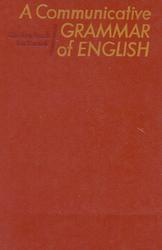This is an introductory course in English grammar for use in English-medium schools, colleges and universities. Lamentably , there is at present no recognised place for English grammar in the British educational curriculum. In fact it is still possible for a student to end up with a degree in English at a British university without having cause to know the first thing about English grammar, or the grammar of any other language. But if we are right in supposing that the time is right for a revival of the subject in schools, there will be a growing need for introductory courses at various levels. Thus this book has a multiple purpose. It is primarily designed as a course book for students at the upper secondary level (sixth forms) and the tertiary level (colleges, polytechnics, universities), but it is also adapted to the needs of teachers interested in exploring a new approach to grammar, or of any person keen to catch up with a subject so wretchedly neglected by our educational system.

Grammar and its role in Language.
It is important from the outset that we are clear about what we mean by the term GRAMMAR in this book. Many people think of grammar as a rather boring school subject which has little use in real life. They may have come across the concept in Latin ‘O’ level, in English composition, or in the explanations of teachers as to what is ‘good’ or ‘bad’ grammar. So grammar is often associated in people’s minds with one of the following ideas: a dead language such as Latin, learning how to write ‘good English’, or learning how to speak ‘properly’. None of these ideas about grammar is completely wrong, but they do not represent the whole picture.
In this book we shall use the term grammar in reference to the mechanism according to which language works when it is used to communicate with other people. We cannot see this mechanism concretely, because it is represented rather abstractly in the human mind, but we know it is there because it works. One way of describing this mechanism is as a set of rules which allow us to put words together in certain ways, but which do not allow others. At some level, speakers of a language must know these rules, otherwise they would not be able to put words together in a meaningful way.
Contents.
Foreword.
Preface.
Symbols and conventions.
PART A: INTRODUCTION.
1. What grammar is and is not.
1.1. Grammar and its role in language.
1.2. ‘Good’ and ‘bad’ grammar.
1.3. Variation in language.
1.4. English and other languages.
1.5. Grammar and effective communication.
1.6. Grammar in prose style.
1.7. Grammar in poetry.
1.8. Conclusion Exercises.
PART B: ANALYSIS.
2. Sentences and their parts.
2.1. Prologue: parts of speech.
2.2. The hierarchy of units.
2.3. Grammatical notations.
2.4. Using tests.
2.5. Form and function.
2.6. Summary Exercises.
3. Words.
3.1. Open and closed word classes.
3.2. The open classes.
3.3. Closed word classes.
3.4. Summary and conclusion Exercises.
4. Phrases.
4.1. Classes of phrase.
4.2. Main and subordinate phrases.
4.3. Noun phrases and related phrase classes.
4.4. The adjective phrase and the adverb phrase.
4.5. The verb phrase.
4.6. Summary Exercises.
5. Clauses.
5.1. Elements of the clause.
5.2. Complex sentences.
5.3. Finite and non-finite clauses.
5.4. Declarative, interrogative and imperative clauses.
5.5. Active and passive clauses.
5.6. More on clause structure.
5.7. Clause patterns.
5.8. The structure of non-finite clauses.
5.9. Parsing a simple sentence.
5.10. Summary Exercises.
6. Subordination and coordination.
6.1. Subordinate clauses.
6.2. Finite subordinate clauses.
6.3. The functions of subordinate clauses.
6.4. Non-finite subordinate clauses.
6.5. Direct and indirect subordination.
6.6. Skeleton analysis.
6.7. Coordination.
6.8. Summary and conclusion Exercises.
7. Basic and derived structures.
7.1. Constituent structure grammar.
7.2. Basic and derived structures.
7.3. ‘Missing’ elements.
7.4. Split constituents.
7.5. ‘Double analysis’.
7.6. Back to parsing.
7.7. Style and transformations.
7.8. Summary and conclusion Exercises.
PART C: APPLICATIONS.
8. Discourse analysis: speech and writing.
8.1. Introductory.
8.2. Speech and writing: which comes first?.
8.3. Functions of writing and speech.
8.4. The form of speech and writing.
8.5. Linguistic characteristics of speech and writing.
8.6. Analysis of spoken and written discourse.
8.7. Conclusion Exercise.
9. Discourse analysis: tenor and domain.
9.1. Introductory.
9.2. Tenor.
9.3. Tenor and discourse.
9.4. Domain.
9.5. Domain and discourse.
9.6. Combining categories of use Exercise.
10. Analysis of literary discourse.
10.1. How to analyse style.
10.2. Illustrative extract.
10.3. Outline analysis.
10.4. Further illustrative extracts for discussion Exercises.
11. Grammar and problems of usage.
11.1. Opinions about grammar.
11.2. Prescriptive ‘rules’.
11.3. The priests of usage.
11.4. The problem of personal pronouns.
11.5. The problem of number concord.
11.6. The problem of the generic masculine.
11.7. Problems of ellipsis.
11.8. Dangling non-finite clauses.
11.9. Conclusion Exercises.
12. Grammar and composition.
12.1. Grammar and writing.
12.2. ‘Make your language easy to follow’.
12.3. ‘Be clear’.
12.4. ‘Be economical’.
12.5. ‘Be clear but concise’: clarity versus economy.
12.6. ‘Be effective’.
Exercises.
Answers to exercises.
Further reading.
Index.
Бесплатно скачать электронную книгу в удобном формате, смотреть и читать:
Скачать книгу English Grammar for Today, A new introduction, Leech G., Deuchar M., Hoogenraad R., 1982 - fileskachat.com, быстрое и бесплатное скачивание.
Скачать pdf
Ниже можно купить эту книгу, если она есть в продаже, и похожие книги по лучшей цене со скидкой с доставкой по всей России.Купить книги
Скачать - pdf - Яндекс.Диск.
Дата публикации:
Теги: учебник по английскому языку :: английский язык :: Leech :: Deuchar :: Hoogenraad
Смотрите также учебники, книги и учебные материалы:
Следующие учебники и книги:
 Just Reading and Writing, Pre-Intermediate, Harmer J., Acevedo A., Lethaby C., 2007 — Just Reading and Writing is designed for individual skills development as part of either a classroom-based course or a self-study … Книги по английскому языку
Just Reading and Writing, Pre-Intermediate, Harmer J., Acevedo A., Lethaby C., 2007 — Just Reading and Writing is designed for individual skills development as part of either a classroom-based course or a self-study … Книги по английскому языку Get Rid of your Accent, James L., Smith O., 2007 — The biggest single factor that affects people s first impression of you is your speech and accent. Wouldn’t you rather … Книги по английскому языку
Get Rid of your Accent, James L., Smith O., 2007 — The biggest single factor that affects people s first impression of you is your speech and accent. Wouldn’t you rather … Книги по английскому языку Grammar Sucks, Kimes J., Muschla G.R., 2007 — With Grammar Sucks, you can put your phobia to rest. Why else should you keep your grammar skills sharp? Following … Книги по английскому языку
Grammar Sucks, Kimes J., Muschla G.R., 2007 — With Grammar Sucks, you can put your phobia to rest. Why else should you keep your grammar skills sharp? Following … Книги по английскому языку Macmillan English Grammar In Context, Intermediate, With key, Vince M., 2008 — This book is designed to revise and consolidate grammar points at the level of Council of Europe Framework (CEF)Bl and … Книги по английскому языку
Macmillan English Grammar In Context, Intermediate, With key, Vince M., 2008 — This book is designed to revise and consolidate grammar points at the level of Council of Europe Framework (CEF)Bl and … Книги по английскому языку
Предыдущие статьи:
 Advanced Language Practice, With key, Vince M., Sunderland P., 2003 — The revised edition of this book is designed with a greater emphasis on text and collocation, in keeping with recent … Книги по английскому языку
Advanced Language Practice, With key, Vince M., Sunderland P., 2003 — The revised edition of this book is designed with a greater emphasis on text and collocation, in keeping with recent … Книги по английскому языку The Advanced Learners’ Grammar, Foley M., Hall D., 2003 — The Advanced Learners’ Grammar is a comprehensive advanced level grammar of the English language with cross-referenced practice exercises and a … Книги по английскому языку
The Advanced Learners’ Grammar, Foley M., Hall D., 2003 — The Advanced Learners’ Grammar is a comprehensive advanced level grammar of the English language with cross-referenced practice exercises and a … Книги по английскому языку IELTS, Examination a workbook for students, Wyatt R., 2001 — This workbook contains exercises that help teach and build English vocabulary. The material covers grammar, use of English, together with … Книги по английскому языку
IELTS, Examination a workbook for students, Wyatt R., 2001 — This workbook contains exercises that help teach and build English vocabulary. The material covers grammar, use of English, together with … Книги по английскому языку Advanced English C.A.E., Grammar Practice, Walton R., 1999 — Focus on Advanced English Grammar Practice provides additional practice to support the main grammar and vocabulary areas found in each … Книги по английскому языку
Advanced English C.A.E., Grammar Practice, Walton R., 1999 — Focus on Advanced English Grammar Practice provides additional practice to support the main grammar and vocabulary areas found in each … Книги по английскому языку




